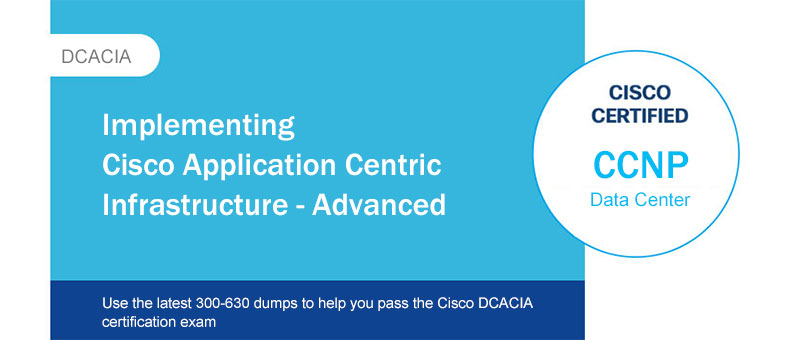
Using 300-630 dumps can help you successfully pass the Cisco DCACIA certification exam on your first attempt.
Because 300-630 dumps have many success advantages:
- Lightweight Learning Tool (PDF+VCE)
- More free usage time (365 days Free Update)
- Covers all Cisco DCACIA practical exam questions and answers, with explanations of difficult problems
- Have a professional Cisco technical team service
So why not use 300-630 dumps to help you easily and successfully pass the exam? And leads4pass, as the provider of 300-630 dumps, has many years of industry reputation, is the industry leader, and is trustworthy, what else do you have to worry about?
Therefore, it is strongly recommended that you use the 300-630 dumps exam material https://www.leads4pass.com/300-630.html, which is up to date throughout the year, to prepare you for a career leap.
More detailed 300-630 DCACIA certification information:
Vendor: Cisco
Exam Code: 300-630
Exam Name: Implementing Cisco Application Centric Infrastructure – Advanced (DCACIA)
Certification: CCNP Data Center
Duration: 90 minutes
Languages: English
Price: $300 USD
Number of Questions: 55-65
300-630 dumps: https://www.leads4pass.com/300-630.html
Cisco 300-630 exam questions online practice test:
Tips: Verify the answer at the end of the article
Question 1:

Refer to the exhibit. How is the ARP request from VM1 forwarded when VM2 is not learned in the Cisco ACI fabric?
A. Leaf 101 forwards the ARP request to one of the proxy VTEP spines.
B. POD1 spine responds to the ARP request after the POD1 COOP is updated with the VM2 location.
C. Leaf 101 encapsulates the ARP request into a multicast packet that is destined to 225.0.37.192.
D. Leaf 101 switch consumes the ARP reply of VM2 to update the local endpoint table.
Question 2:
Which approach does Cisco ACI use to achieve multi-destination packet forwarding between leaf switches in the same fabric?
A. Map VXLAN VTEP to the multicast group
B. Map VXLAN to PIM-SM protocol
C. Map VXLAN VNI to the multicast group
D. Map VXLAN to PIM-DM protocol
Question 3:
What does the VXLAN source port add to the overlay packet forwarding when it uses the hash of Layer 2, Layer 3, and Layer 4 headers of the inner packet?
A. ECMP
B. TCP optimization
C. disabled fragmentation
D. jumbo frames
Question 4:
Which two actions are the Cisco best practices to configure NIC teaming load balancing for Cisco UCS B-Series blades that are connected to the Cisco ACI leaf switches? (Choose two.)
A. Create vPC+
B. Enable LACP active mode
C. Create PAgP
D. Create vPC
E. Enable MAC pinning
Question 5:

An organization migrates its virtualized servers from a legacy environment to Cisco ACI. VM1 is incorrectly attached to PortGroup IT|3TierApp|Web. Which action limits IP address learning in BD1?
A. Enable Enforce Subnet Check
B. Enable Rouge Endpoint Control
C. Enable GARP-based EP Move Detection Mode
D. Disable Remote EP Learn
Question 6:
What is the purpose of the Forwarding Tag (FTAG) in Cisco ACI?
A. FTAG is used in Cisco ACI to add a label to the iVXLAN traffic in the fabric to apply the correct policy.
B. FTAG is used in Cisco ACI to add a label to the VXLAN traffic in the fabric to apply the correct policy.
C. FTAG trees in Cisco ACI are used to load balance unicast traffic.
D. FTAG trees in Cisco ACI are used to load balance multi-destination traffic.
Question 7:

Refer to the exhibit. Which three actions should be taken to implement the vPC in the Cisco ACI fabric? (Choose three.)
A. Select a common vPC interface policy group
B. Select individual interface profiles
C. Select common interface profiles
D. Select individual switch profiles
E. Select common switch profiles
Question 8:
Which action should be taken in Cisco ACI to reassign a unique globally scoped pcTag to an EPG that provides a global contract?
A. Configure subnets that are treated as virtual IP
B. Configure subnets that advertise externally
C. Configure subnets that are shared between VRFs
D. Configure subnets that are private to VRF
Question 9:

Refer to the exhibit. What must be configured in the service graph to redirect HTTP traffic between the EPG client and EPG server to go through the Cisco ASA firewall?
A. contract filter to allow ARP and HTTP
B. precise filter to allow only HTTP traffic
C. contract with no filter
D. permit-all contract filter
Question 10:

Refer to the exhibits. Which subject must be configured for the All_noSSH contract to allow all IP traffic except SSH between the two EPGs?
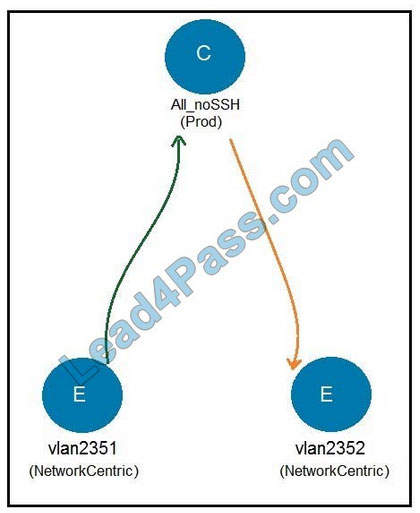
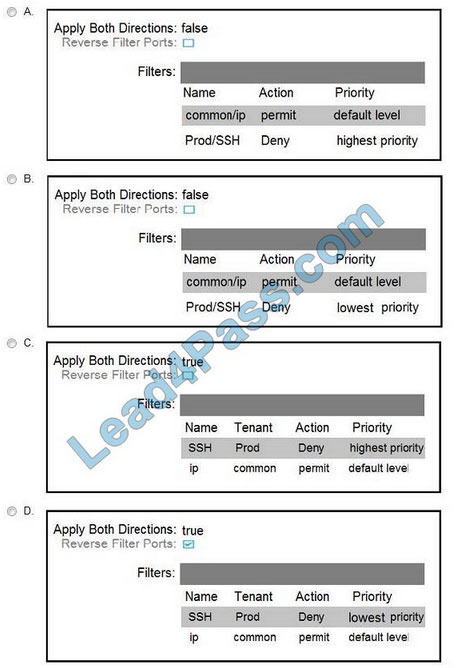
A. Option A
B. Option B
C. Option C
D. Option D
Question 11:

Refer to the exhibit. Two application profiles are configured in the same tenant and different VRFs. Which contract scope is configured to allow communication between the two application profiles?
A. global
B. VRF
C. application
D. tenant
Question 12:

Refer to the exhibit. Which two configurations enable inter-VRF communication? (Choose two.)
A. Set the subnet scope to Shared Between VRFs
B. Enable Advertise Externally under the subnet scope
C. Change the contract scope to Tenant
D. Change the subject scope to VRF
E. Export the contract and import as a contract interface
Question 13:
Which two actions should be taken to ensure a scalable solution when multiple EPGs in a VRF require unrestricted communication? (Choose two.)
A. Configure a taboo contract between the EPGs that require unrestricted communication between each other.
B. Enable Preferred Group Member under the EPG Collection for VRF section.
C. Set the VRF policy control enforcement preference to Unenforced.
D. Set the EPGs that require unrestricted communication between each other as preferred group members.
E. Set the EPGs that require policy enforcement between each other as preferred group members.
Question 14:
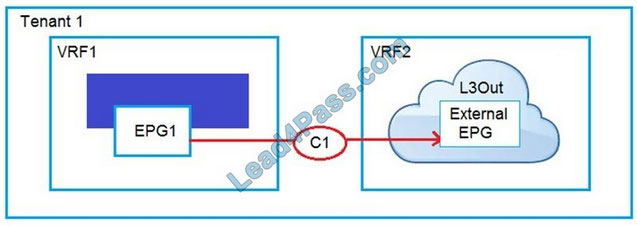
Refer to the exhibit. An engineer must have communication between EPG1 in VRF1 and External EPG in VRF2. Which three actions should be taken for the defined subnets in the L3Out External EPG to accomplish this goal? (Choose three.)
A. Enable Shared Route Control Subnet
B. Enable External Subnets for External EPG
C. Enable Export Route Control Subnet
D. Enable Shared Security Import Subnet
E. Enable Aggregate Shared Routes
F. Enable Import Route Control Subnet
Question 15:
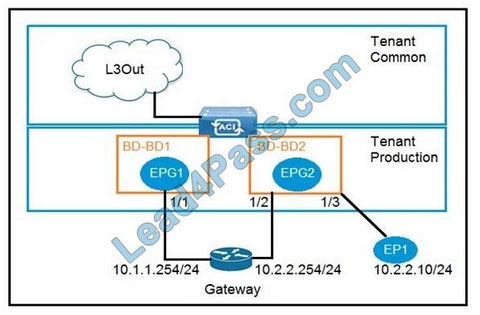
Refer to the exhibit. An engineer wants to avoid connectivity problems for the endpoint EP1 when it reaches an external L3Out network through the gateway 10.2.2.254/24. Which two configurations must be implemented in BD-BD2? (Choose two.)
A. Disable unicast-routing
B. Enable IP data plane learning for the VRF
C. Disable ARP flooding
D. Enable ARP flooding
E. Enable unicast-routing
……
verify answer:
| Numbers: | Q1 | Q2 | Q3 | Q4 | Q5 | Q6 | Q7 | Q8 | Q9 | Q10 | Q11 | Q12 | Q13 | Q14 | Q15 |
| Answers: | A | C | A | BE | C | D | ABE | C | A | D | D | BE | CD | CDF | AC |
CCNP Data Center certification includes: Core exam and Concentration exams, Cisco DCACIA certification exam are one of the Concentration exams certification exam, Concentration exams can be chosen arbitrarily, and the Core exam (300-630 DCACIA) is the only one.
Select leads4pass 300-630 dumps https://www.leads4pass.com/300-630.html,
Helping you 100% pass the Cisco DCACIA certification exam. All CCNP Data Center certification programs are available in leads4pass and can ensure that you pass the exam with a high score.
